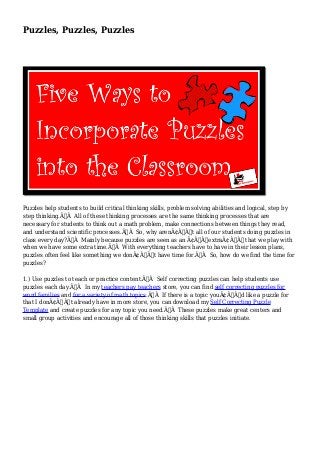
Puzzles, Puzzles, Puzzles
- 1. Puzzles, Puzzles, Puzzles Puzzles help students to build critical thinking skills, problem solving abilities and logical, step by step thinking. All of these thinking processes are the same thinking processes that are necessary for students to think out a math problem, make connections between things they read, and understand scientific processes. So, why aren’t all of our students doing puzzles in class every day? Mainly because puzzles are seen as an “extra†that we play with when we have some extra time. With everything teachers have to have in their lesson plans, puzzles often feel like something we don’t have time for. So, how do we find the time for puzzles? 1.) Use puzzles to teach or practice content. Self correcting puzzles can help students use puzzles each day. In my teachers pay teachers store, you can find self correcting puzzles for word families and for a variety of math topics. If there is a topic you’d like a puzzle for that I don’t already have in more store, you can download my Self Correcting Puzzle Template and create puzzles for any topic you need. These puzzles make great centers and small group activities and encourage all of those thinking skills that puzzles initiate.
- 2.    2.) Model how to solve puzzles while modeling how to solve math word problems. Tiling puzzles are often extremely challenging for students when they are first introduced. Because of this, I recommend working through the first puzzle with students in a modeled “think aloud†process. When modeling puzzles like these, take the time to highlight for students how similar these same thinking processes can be used to solve a word problem.  ÂÂ
- 3. 3.) Use puzzles to practice geography. Include map puzzles into your Maps and Globes unit. Let students take the time to put together those continents or the states of the US and they will have a much more concrete understanding of how those locations relate to each other.  4.) Let students have 5 minutes each day to work on puzzles as an activator. Set up four or five regular jigsaw puzzles in empty pizza boxes. Small dollar store puzzles work best as they tend to be very small when complete – and they’re cheap! Assign students to a puzzle by simply writing their names on the top of the pizza box (this is a great time to build in differentiation by leveling the pizza boxes with puzzles of different difficulties and grouping your students accordingly). At the beginning of your math block, set a timer for five minutes and let the students get their pizza box and work on their puzzle until the timer runs out, in an exercise to warm up their brains and get them ready for critical thinking. When a group completes a puzzle, hand out a simple award (I like stickers.) and replace the puzzle with a new one.  5.) Assign puzzles for homework. Students and parents alike complain about homework, but who is going to complain about working on a puzzle? Send home tiling puzzles once students have had some exposure to these types of puzzles or have students work on puzzles using a website like Jigzone.com. What interesting ways do you have to incorporate puzzles into your classroom? http://feedproxy.google.com/~r/rakisradresources/NlKY/~3/GvNB18PkOd4/puzzles-puzzles-puzzles.h tml I hope you've found this article as remarkable like I did. I'm really looking forward to reading your voice concerning this . When it has arouse your interest aboutenglish worksheets for kids activities you can find more on this on here also.